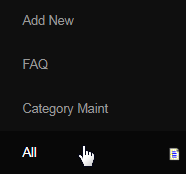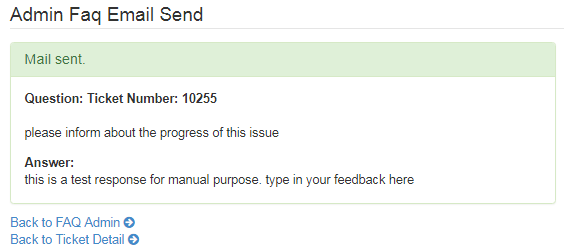Go to FAQ Admin > All from the left hand menu or click on All under FAQ Admin on the home page.

As the name represents, this page contains the record of all the tickets arranged according to the date of last updates. This is a general listing which also acts like log, but does contain the features to open and manage the tickets similar to that of the New or Open interface. The admin or the CSRs can look for a ticket here, irrespective of any assignee or status (if it cannot be found anywhere else). Below is a description of the attributes of the table;
- TicketID: This is a unique identification number (or the primary key) of the ticket, by which it is identified. Click on it to open the same.
- Username: The username of the member who raised or submitted the ticket. Clicking on this would take you to the DistMaint of the user.
- Notes: A short description or comment added by the CSR for a reference. In this case, New tickets will not contain any notes.
- Category Type: The category under which the issue can be classified (as selected by the user). Click here to learn more about the Category Maint.
- Language: The language in which the ticket is submitted. You may have multiple languages enabled for your business and separate CSRs for that.
- Assignee: The username of the member or the support staff to whom the bug has been assigned to or the user in-charge.
- Status: The current status of the bug. See below for the description of different types of status available (can be used).
- Updated: It displays the date and time when the ticket was edited or updated by latest. In this case, it shows the date and time of submission.
- Question: The preview of the question or issue in concern. It will appear blank if the latest update did not include any content in response box.

The functsions and attributes are same as explained in FAQ Admin > New manual page. Learn more by clicking here. Here's a brief description of the same.
- You can sort the order of display of the tickets based on your chosen attribute. Click on the column name by which you want to arrange the list.
- If the list is long, then you can search your criteria through various filters. Notice the search engines and filters just below the header column.
- You can adjust the table size by selecting the number of entries to be displayed. Use the navigation buttons at the bottom to move between pages.
- Select: You need to tick on the check-box corresponding to the ticket that you want to take action on, before clicking on the respective button.
- Delete Selected: Clicking on this button will remove the selected tickets from the New list (although it would still appear in FAQ Admin > All).
- Assign to: Clicking on this button will bring up the Assign Ticket box, where you can select to whom you want to assign the selected tickets.
- Click on the TicketID link to open the ticket to get a full view, where you can manage the same. It will take you to the FAQ editing page.

- At the top, notice the message displayed, where it says that the ticket is locked to the [[username]] for 25 minutes (in this case, yourself).
- The Details section contains the information about the ticket, i.e. name and username of the reporter, status and assignment details, etc.
- Then the Ticket section contains the fields and functions to handle the feedback as per your requirements. Listing the introduction of the fields below;
- Respond: Clicking on this link will jump the cursor to the Response text-box, where you can start answering the question straight away.
- Add Admin Note: Clicking on this link will bring up the Admin Only Note box, where you can add a message for the selected support staff.
- Personal Greeting: The greetings message/content for the feedback. Click on the Edit link to change the content as preferred (autosave).
- Add to FAQ: Tick on this check-box, if you think that this question/answer is fit to appear in the FAQ list (made public to all members).

- Question: The preview of the question or issue in concern. This would appear in a text-box, if the Add to FAQ box is checked.
- Response: This is where you type in the answer to the query. Expand the box from the bottom right corner to the required size to get a full view.

- Personal Signoff: The sign-off message appended to the response. Click on the Edit link to change the content as preferred (autosave).
- Add to members lounge messaging interface: Check the box if you want to send the response as a message to the Members Lounge.
- Stamp reply note into distributor notes: Check the box if you want to stamp the question/answer as a note in the DistMaint of the member.
- Send Email to Customer: Check the box if you want to email the response to the member through their registered email address.
- Optional File Upload: You can attach any document, like screenshots (images) to support your answer. Click on the Browse button to select and open the file from your local computer. You will notice that the file name gets populated in the box next to it. Be aware of the size per file limit.

Before submitting the response, you can change the Category, Language and Status of the ticket by selecting the option as follows:
- If you want to add this ticket to the FAQ and make sure it goes under a different category/language, then select the correct option from the drop-list.
- You can view the status of the ticket based on your requirements. By default, the value is Closed Resolved. Here's a description of the options;
- New: The ticket will be posted in the FAQ Admin > New listing. It will treated as a New ticket (along with the response).
- Open: The ticket will be posted in the FAQ Admin > Open listing. It will treated as a New ticket which has not been closed yet.
- Pending Customer: This means that you are waiting for feedback or more information from the member for further investigation.
- Pending Support: This means that you are holding the ticket for deeper investigation by support and that you need more time.
- Closed Unresolved: This means that the ticket is not required to be solved (or has been solved) and that you are closing the issue.
- Closed Resolved: This means that the ticket has been answered or the issue has been resolved and that you are closing it. Default status.
- Archived: The ticket will be transferred to a less frequently used folder (archived), which you may require to act as a reference in the future.
- Once you are satisfied with the edits/data and have chosen your preferences, click on the Submit to Customer button to commit to the changes.

After submitting the response, you will be redirected to the Admin Faq Email Send page. If everything goes well, you will see the message, Mail sent along with a summary of the response. The page provides two quick links for your easy navigation: Back to FAQ Admin and Back to Ticket Detail.

